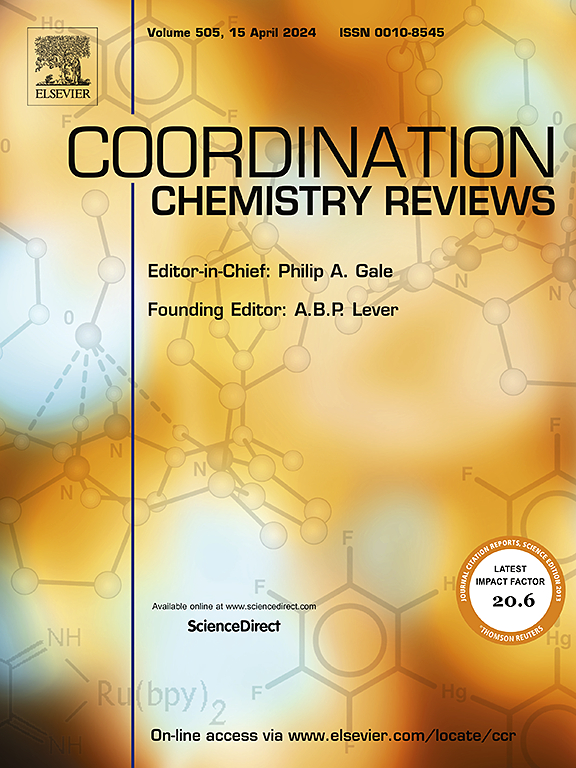Macrocyclic arene-based metal-organic cages
IF 20.3
1区 化学
Q1 CHEMISTRY, INORGANIC & NUCLEAR
引用次数: 0
Abstract
This review explores the field of discrete metal-organic cages (MOCs) constructed using macrocyclic arenes (MAs) as key structural components, a subject that has garnered significant interest in recent years because of their fascinating architectures, precisely structured cavities, along with extensive utility in molecular recognition, host-guest interactions, catalysis, and gas separation, and so on. The review highlights recent advancements in the synthesis of MA-based MOCs, emphasizing two principal assembly approaches: (i) the direct coordination of macrocyclic arenes with metal ions, and (ii) the integration of macrocyclic arenes with metal ions and additional linkers. The discussion is organized according to the types of macrocyclic arenes utilized, including calixarenes, resorcinarenes, pyrogallolarenes, cyclotriveratrylenes, and pillararenes, with a focus on formation mechanisms, structural features, structure-function relationships, and applications of these MA-based MOCs. Additionally, the review addresses current existing challenges in the field and provides perspectives on future directions for the development and utilization of MA-based MOCs.

大环芳烃基金属有机笼
本综述探讨了以大环芳烃(MAs)为主要结构成分构建的离散金属有机笼(MOCs)领域,近年来由于其迷人的结构,精确结构的腔体,以及在分子识别,主客相互作用,催化和气体分离等方面的广泛应用而引起了人们的极大兴趣。综述了基于ma的MOCs合成的最新进展,强调了两种主要的组装方法:(i)大环芳烃与金属离子的直接配位,以及(ii)大环芳烃与金属离子和附加连接剂的集成。根据所使用的大环芳烃的类型,包括杯芳烃、间苯二甲酸芳烃、邻苯三食子芳烃、环三戊二烯和柱芳烃,重点讨论了这些基于ma的moc的形成机制、结构特征、结构-功能关系和应用。此外,本文还讨论了该领域目前存在的挑战,并对基于ma的moc的开发和利用的未来方向提出了展望。
本文章由计算机程序翻译,如有差异,请以英文原文为准。
求助全文
约1分钟内获得全文
求助全文
来源期刊

Coordination Chemistry Reviews
化学-无机化学与核化学
CiteScore
34.30
自引率
5.30%
发文量
457
审稿时长
54 days
期刊介绍:
Coordination Chemistry Reviews offers rapid publication of review articles on current and significant topics in coordination chemistry, encompassing organometallic, supramolecular, theoretical, and bioinorganic chemistry. It also covers catalysis, materials chemistry, and metal-organic frameworks from a coordination chemistry perspective. Reviews summarize recent developments or discuss specific techniques, welcoming contributions from both established and emerging researchers.
The journal releases special issues on timely subjects, including those featuring contributions from specific regions or conferences. Occasional full-length book articles are also featured. Additionally, special volumes cover annual reviews of main group chemistry, transition metal group chemistry, and organometallic chemistry. These comprehensive reviews are vital resources for those engaged in coordination chemistry, further establishing Coordination Chemistry Reviews as a hub for insightful surveys in inorganic and physical inorganic chemistry.
 求助内容:
求助内容: 应助结果提醒方式:
应助结果提醒方式:


